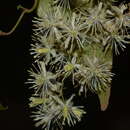zh-TW
在導航的名稱


मूर्वा (वानस्पतिक नाम : Clematis Gouriana) या 'मरोड़फली' नाम की लता हिमालय के उत्तराखण्ड को छोड़ भारतवर्ष में और सब जगह होती है। इसमें सात-आठ डंठल निकलकर इधर उधर लता की तरह फैलते हैं। फूल छोटे छोटे, हरापन लिए सफेद रंग के होते हैं। इसके रंशे बहुत मजबूत होते हैं जिससे प्राचीन काल में उन्हें वटकर धनुष की डोरी बनाते थे। उपनयन में क्षत्रिय लोग मूर्वा की मेखला धारण करते थे। एक मन पत्तियों से आधा सेर के लगभग सुखा रेशा निकलता है, जिससे कहीं कहीं जाल बुने जाते हैं। त्रिचिनापल्ली में मूर्वा के रेशों से बहुत अच्छा कागज बनता है। ये रेशे रेशम की तरह चमकीले और सफेद होते हैं। मूर्वा की जड़ औषध के काम में भी आती है। वैद्य लोग इसे यक्ष्मा और खांसी में देते हैं। आयुर्वेद में यह अति तिक्त, कसैली, उष्ण तथा हृदयरोग, कफ, वात, प्रमेह, कुष्ठ और विषमज्वर को दूर करनेवाली मानी जाती है।
Clematis gouriana, or Indian Traveller's Joy,[1] is a liana found in Asia which belongs to the buttercup family (Ranunculaceae).[2] It was described by Roxb. ex DC. and published in Regni Vegetabilis Systema Naturale 1: 138-139, in 1818.[3]
The creeper occurs in the Himalayas from Pakistan, India, eastward through Nepal, Bhutan, Bangladesh and into western and southern China.[4][5] The hilly districts of the Western Ghats, the eastern part of the India subcontinent, and Sri Lanka.[1][5] In India, the creeper occurs in the states of Himachal Pradesh, Punjab, Haryana, Uttar Pradesh, Bihar, Orissa, Madhya Pradesh, Andhra Pradesh, Maharashtra, Karnataka, Kerala, Tamil Nadu, West Bengal, Sikkim, Assam, Meghalaya, Arunachal Pradesh, Nagaland, Manipur and Tripura.[5] The creeper is common in the Western Ghats, and the patches of adjoining forest of the Konkan coast and the Deccan plateau.[2]
A large climbing shrub, reaching up to the canopies of trees. Glabrous, except for the younger parts of the plant. Grooved stem and branches. Leaves are pinnate, sometimes bi-pinnate or tri-pinnate. Leaflets may be ovate or oblong acuminate, with nerves and reticulate venation, and have a shining surface. Small flowers in many branched pannicles. Each flower is 1 to 1.5 inches wide, fragrant and greenish-white. Petals are absent but four greenish sepals present which are oblong-ovate and covered with soft down. Many stamens, with free, narrow and straight filaments which thicken towards the top. Compressed achenes, narrowly ovoid or oblong, with persistent feathery style.[1][2][6][7][8]
C. gouriana is a vigorous climber spreading on thickets and climbing on trees. Principally in tropical and subtropical forests.[5] It occurs up to 5,000 feet (1,500 m) in the Himalayas; in the hilly districts of the peninsula it occurs between 1,000 feet (300 m) and 3,000 feet (910 m).[9] Flowering takes place from August to February, while fruits appear from September to May.[5]
C. gouriana is recognised as a medicinal herb in traditional medicine and amongst tribal communities. It has been investigated for its medicinal properties.[10]
The bruised leaves and stem act as a vesicant and are poisonous.[11] In Ayurveda, the leaves of the plant have been used for treating puerperal fever and bruises.[12] Leaf paste is applied to wounds of cattle by Jatapu, Khond and Savara tribals of Andhra Pradesh, India.[5]
In Himachal Pradesh, the plant is called Takri: 𑚏𑚮𑚠𑚖𑚱 ISO: cibaḍū or Takri: 𑚏𑚮𑚠𑚤𑚱 ISO: cibarū. [13]
Clematis gouriana, or Indian Traveller's Joy, is a liana found in Asia which belongs to the buttercup family (Ranunculaceae). It was described by Roxb. ex DC. and published in Regni Vegetabilis Systema Naturale 1: 138-139, in 1818.
Clematis gouriana es una especie de liana de la familia de las ranunculáceas.
Es un bejuco leñosos. Las ramas de 3 a 5 m, ramas longitudinales de 5 ranuras, glabrescentes y pubérulas. Hojas pinnadas, 5-folioladas; pecíolo de 1 - 7 cm, escasamente pubérulas a subglabras; ovaladas, estrechamente ovadas, o lanceoladas, de 2.4 - 10.5 × 1.2 a 5.5 cm, como de papel, ambas superficies glabras, la base redondeada a subcordada, el margen entero, el ápice atenuado a acuminado; las venas basales con el envés prominente. Las inflorescencias son axilares o terminales en cimas, con 9 - 100 flores, y pedúnculo de 1.2 - 7 cm, brácteas simple o foliáceas, triangulares a ovadas, de 4 - 10 mm. Flores de 7 a 10 mm de diámetro. Pedicelo 6 a 12 mm. Sépalos 4, color blanco. Los frutos son aquenios lanceoladas a fusiformes, 3 a 3,5 × 1 a 1,5 mm. Fl. septiembre-octubre, fr. noviembre-diciembre.[1]
Se encuentra en las pendientes, matorrales, a lo largo de los arroyos, por debajo de 100 - 1800 msnm, en Cantón, Guangxi, Guizhou, Hubei, Hunan, Sichuan, Yunnan en China y en Bután, India, Birmania, Nepal, Nueva Guinea, Filipinas y Sikkim.
Clematis gouriana fue descrita por Roxb. ex DC. y publicado en Regni Vegetabilis Systema Naturale 1: 138–139, en el año 1818[2]
Clematis: nombre genérico que proviene del griego klɛmətis.[3] (klématis) "planta que trepa".
gouriana: epíteto
Clematis gouriana es una especie de liana de la familia de las ranunculáceas.
Clematis javana là một loài thực vật có hoa trong họ Mao lương. Loài này được DC. mô tả khoa học đầu tiên năm 1817.[1]
Clematis javana là một loài thực vật có hoa trong họ Mao lương. Loài này được DC. mô tả khoa học đầu tiên năm 1817.